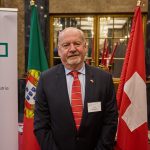Greenvolt – leading the way in Portugal in urban green energy communities
Text: Chris Graeme; Photos: Colorshop
One Portuguese renewables company that undoubtedly is at the heart of fulfilling Portugal’s National Energy Climate Plan 2030 is Greenvolt.
Founded in 2021 by former EDP Renováveis CEO (2012-2021) João Manso Neto, Greenvolt is dedicated to producing large-scale solar, wind and biomass projects and is currently listed on Portugal’s PSI20 (Euronext Lisbon stock market) that represents the largest listed companies in the country.
Floated on the stock market on July 15, 2021 – the initial public offering (IPO) price was €4.25 – , today it is €8.22 with its main shareholders including institutional investors like KKR & Co. Inc. A portion of the company’s shares are held by the public (free float), with a significant portion also held by private individuals, with some of these listed on Euronext Live Markets. Additionally, the company’s website lists key shareholders, including MarketScreener.
The company arose as a subsidiary of the Portuguese company Altri – a company that focuses on producing cellulosic fibers, primarily from eucalyptus, and also engages in sustainable forest management and renewable energy production, and today Greenvolt is a pioneer in Portugal for urban green energy communities.
Which was why it was interesting that the CEO of this dynamic and forward-looking company should address a select group of corporate members of the British-Portuguese Chamber of Commerce (BPCC) at a corporate lunch held at the British ambassador’s residence in Lisbon on Tuesday, May 6.
A leader in biomass
Greenvolt today is the leading producer of biomass energy in Portugal and it also operates two biomass projects in the UK – more specifically in Tilbury and Kent. Specifically. Greenvolt owns Tilbury Green Power in the Port of Tilbury, Essex, and acquired Kent Renewable Energy, located in Sandwich, in Southeast England.
In addition, the company is also developing large-scale renewable energy projects globally in 20 different countries across Europe, North America, and Asia (including Indonesia). These projects include solar, wind, and energy storage facilities. Specifically, they have operations in several European markets, the USA, and Japan, with a total pipeline of 9.3 GW. They also have projects in Poland, Romania, and Germany.
The company is also a leader in decentralised energy production through individual and collective self-consumption solutions or energy communities.
João Manso Neto is certainly one of the most respected leaders in the green energy sector in which he was worked since 2003 after 21 years in banking (BCP in Portugal and Poland), and was on the board of directors at EDP Renováveis.
Opinions not truth
Stating from the onset that he would not speak “truths but rather opinions”, João Manso Neto said that in energy there was no single truth and that “we should not think that we know everything”.
“It is impossible to continue consuming fossil fuels as we had been doing, both because of the negative impact they have on the environment, and because of their scarcity, which results in increasingly higher prices, as well as putting countries that don’t have these resources in a position of dependence”, he said.
“Energy transition is a ‘must’ because we are facing climate changes which we must mitigate. It is a must for three reasons: it does not emit CO2, it counteracts energy security reliance and threats (which has become important since the Russian invasion of Ukraine in 2022), and third, because it is cheaper for consumers”.
Renewables – don’t need subsides but quicker licensing
The Greenvolt CEO argued that renewable energy projects, particularly involving photovoltaic panels, didn’t need subsidies and were cheap.
“So, if they are cheaper, why don’t we have more knowing that decarbonisation has not only to do with electricity? On the contrary it has to do with using more electricity, but the big bottleneck to expanding renewables is licensing and regulations”, he said.
In order to solve the problem, licensing had to be quicker, so instead of taking six or nine months, decisions needed to be cut to two or thee months, while decision-making needed to be aggregated and shouldn’t have to be taken by several different bodies and authorities for the same project.
But there was another issue to do with the decision-makers. “I am talking not only about the private sector, but fundamentally about the public sector because the public sector is the largest owner in the country, if we include the municipal councils, the government and regulatory bodies”.
This had nothing to do with the budget. “Subsidies were needed for large projects using storage batteries, whereas smaller projects using only solar panels do not need subsidies”.
Renewables – a blot on the landscape?
Another issue was aesthetics in cases where land or coastal areas were occupied by large solar parks and wind farms. “If you replace a forested area or farming land with solar panels it doesn’t look fantastic and doesn’t bring value. It might solve one problem, but creates two and no one will accept that”.
On the other hand, if one compares what can be done today with what we could do 10 years ago, things have become more complex. “If you travel from Lisbon to Porto on the motorway there are lots of wind turbines overlooking the road and near people’s houses. “Is this sensible? It’s not. Turbines are noisy and sometimes catch fire.”
In other words, there needed to be a balance with biodiversity, the landscape and people or a balance between ecological efficiency and sociological impact. So what is the answer?
The advantages of energy communities
João Manso Neto concluded that while there was space for large-sized projects providing there was a good link to the networks, priority should be given to decentralised projects that were more “human”, and of a smaller scale within the urban and community environments.
Such smaller projects brought several advantages for consumers. For example, solar panels on buildings enabled self consumption of renewable energy for companies or residential areas, bringing environmental benefits while lowering energy bills.
“We are also seeing a marked growth in energy communities that, in practice, allow those who generate more energy than they consume to share it with other consumers within a radius of up to four kilometers. It is a win-win solution for those who produce, those who consume and society as a whole”, he said.
But how does it work in terms of customer billing? In energy communities, billing typically involves members paying for their share of locally generated renewable energy based on pre-defined shares and prices.
The community can either act as a supplier to its members or work with an external supplier. Energy sharing within the community is a core concept, and the financial benefits are impacted by both internal community rules and external factors like regulatory frameworks.
But does it work out cheaper for customers? Apparently, yes, according to João Manso Neto because energy communities generally lead to lower electricity bills for their members. By investing in renewable energy sources like solar panels or wind turbines and sharing the generated electricity within the community, members can benefit from reduced energy costs compared to relying solely on the national grid.
In energy communities, bills are typically issued by the entity that manages the distribution of electricity generated within the community. This could be a local energy cooperative (REC) or a citizen energy community (CEC) that is directly involved in generating, distributing, and selling electricity within the community. National legislation often outlines the roles and responsibilities of these entities, including how they manage billing and payment processes.
So does Greenvolt issue bills to customers using energy shared through communities? Greenvolt doesn’t directly issue the bills in energy communities. Instead, it assists in creating and managing energy communities, helping to attract members and facilitate the sharing of energy.
Greenvolt focuses on enabling these communities to benefit from clean, cheaper energy by connecting producers with consumers. The billing process remains with the individual electricity distributors, as the energy community structure allows for sharing excess energy and potentially lower bills, rather than a complete shift in billing responsibility.
Case study: Belenenses Football Club
For example, solar panels could be installed on the roof of a factory, a hospital, school, office building or football stadium and the excess power generated could be sold to residential communities nearby. “Who is going to be against it. Nobody and could represent up to 25% of renewable energy needs”, says Manso Neto.
One concrete example is Belenenses Football Club which in partnership with Greenvolt has implemented a renewable energy community focused on 1000 solar panels.
This project aims to reduce the costs of electricity by 32% for the club while selling excess capacity to the other member of the community.
These panels have a 595 MWp to annually generate 840 MWh of green energy and thereby reduce C02 emissions by 223 tonnes per annum.
Not only this, it reduces the need for more power lines, pylons and substations, as well as as avoiding problems such as a lack of connection, network or energy losses through energy transport, all of which make energy more expensive.
“Today we have around 65 energy communities operating whereas two years ago we only hand a handful, so things are moving in the right direction”, concluded João Manso Neto.
UK – Europe’s leader in green energy transition
Nicola Davis, the Political and Economic Councillor at the British Embassy, gave a brief resume about the UK government’s energy and climate policy at the lunch -, one of the “key areas that unites Portugal and the UK in terms of their commitment to sustainable economic practices that are in balance with economic growth with the responsible use of natural resources and the increasing use of renewable energy sources”.
The UK, she said, had some of the most ambitious targets in the world with a commitment to net zero carbon emissions by 2050 and to fully decarbonise the electricity system by 2030 which would be faster than any other major economy, with the aim of making the UK a green energy superpower by 2030.
“The current government has lifted a ban on onshore wind energy and set a goal to halve the time it take to get approval for offshore wind farm projects”.
The principles underpinning the government’s policy were threefold: 1) Ensure a secure and affordable energy supply. 2) Create new industries and investments, boost technological innovation and create thousands of new jobs across the UK. 3) To protect the environment from the most harmful effects of climate change.
Portugal too has similar ambitious green targets in its National Energy Climate Plan 2023 with a commitment to reach carbon neutrality by 2045 and reduce emissions by 55% by 2030.
“Given our shared objectives and challenges in this area, cooperation between our two countries has never been more important,” she concluded.










